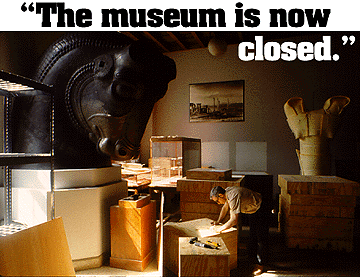
 The University of Chicago Magazine June 1996
The University of Chicago Magazine June 1996
The Oriental Institute's rare collection of antiquities attracts visitors from around the world. With those artifacts in peril, extreme measures are being taken, including the unthinkable...
By Tim Andrew Obermiller
Photography by Lloyd DeGrane
The shut gallery's overhead lights have been sensibly switched off, and soft light from a southern bank of windows yields a pale morning glow. Behind the glass of a display case, the wide, painted eyes of a Sumerian statuette gaze as if in amazement as Laura D'Alessandro swiftly wipes thick dust from a pair of stacking chairs, and motions her visitor to be seated. It's the third time the conversation has moved-hammer blows in the vicinity of her basement office shattered a first attempt.
The second try was made upstairs beneath an 11-foot-high carved stone relief that in the 8th century B.C. adorned the palace walls of the great Assyrian king Sargon II. Excavated at the site of Khorsabad in northern Iraq by U of C archaeologists, this relief and 13 others-depicting king, courtiers, and the trappings of royal life-have been displayed in the Oriental Institute Museum since the 1930s. Soon workmen will begin to pry them free from the Assyrian gallery walls, which themselves will be demolished.
D'Alessandro, the institute's head conservator, looks tired, even a bit stressed, from the demands of renovation work being done here and throughout the building. That labor began in 1994 and should end in 1998, when the museum-closed this spring-reopens, and construction of a new three-story addition to the south is finished.
As she explains the need for this work, D'Alessandro's soft voice echoes in the gallery, now emptied of the elegant wooden cases used to display smaller objects recovered at Khorsabad-treasures boxed and filed away in storage elsewhere in the building.
"The museum world has recognized that artifacts require a stable environment-," she begins, but her words are swallowed by a cacophony of voices and the sharp clatter of boards. D'Alessandro scarcely notices, no doubt used to such disruptions, but smiles agreeably at her listener's plea for some quieter place and motions to the adjacent Mesopotamian hall-one of only two of the museum's five galleries that has yet to be dismantled.
Finally seated and away from the hubbub, D'Alessandro relaxes,
Continue reading, "The Museum is now closed."
Go to:
Return to June 1996 Table of Contents